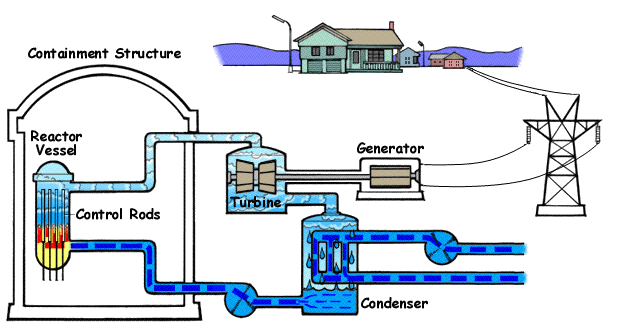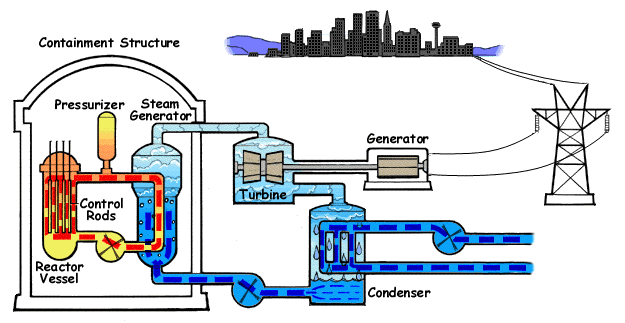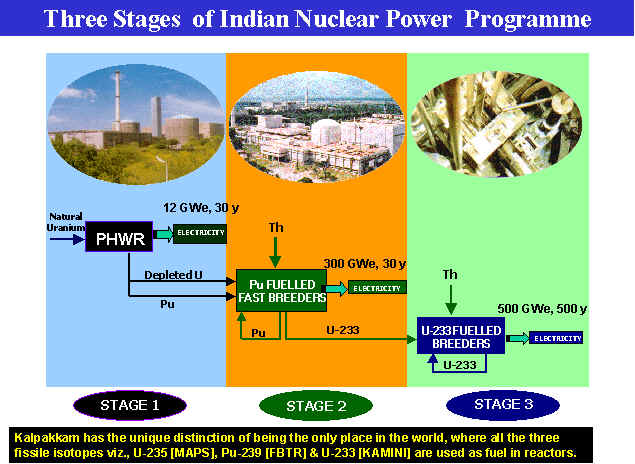A nuclear reactor is a system where a controllable nuclear fission chain reaction can be maintained. The principal parts of reactor are
1. The core:
This is the main part containing the nuclear fuel. The solid fuel material is fabricated into various small shapes – plates, pellets, pins etc., which are usually put together and called as sub-assemblies or bundles.
Fuel elements: A reactor core may contain from tens to hundreds of these fuels sub-assemblies, held in a fixed geometrical pattern.
2. Moderator:
The moderator is a material that has the ability to slow down neutrons quickly and which at the same time has little tendency to absorb neutrons. Moderator is used in thermal reactor to slow down the neutrons as the fuel has high fission cross-section for low energy neutrons.
Materials used as moderators include ordinary water, heavy water, graphite, beryllium and certain organic compounds.
The moderator should be well distributed within the fuel zone or core. In some reactors the fuel materials and moderator materials are intimately mixed together.
3. Reflector:
The reflector reduces the leakage of neutrons by reflecting back the neutrons escaping from the core. The same material used for moderator can be used for the reflectors in the case of thermal reactors.
In the fast reactors where fast neutrons are utilized for fission, nickel, molybdenum and stainless steel reflectors are used.
4. The Cooling System:
This system removes the heat released from the reactor core. It consists of pipes through which the coolant is pumped. When passing through the reactor cores, the coolant picks up the heat, transfers the heat to another working medium through a heat exchanger and then returns to the reactor. Gases, heavy and light water, and liquid metals such as sodium, lithium, potassium etc., can serve as coolants. In a reactor, we must be able to control the amount of heat produced. The heat produced depends upon the number of fissions taking place per second in the reactor, which in turn depends upon the number of neutrons present in the reactor.
5. The Control System:
The control system is designed to control the number of neutrons, thus control the rate of the chain reaction and power level.
This system includes a number of devices, sensing elements that measure the number of neutrons in the reactor, control rods – containing strong neutron absorbers such as cadmium or boron, and other devices to regulate the position of the control rods. These neutron absorbing control rods when lowered into the reactor absorb the neutrons to reduce the neutron population and when raised allow the rise in number of neutrons. It is also possible to control a reactor by increasing or decreasing its size. (Increasing the size reduces the leakage of neutrons and vice versa). Hence some reactors are controlled by varying the level of moderator. In the heavy water moderated reactors like Candu, a combination of moderator level control and neutron absorber rods are used.
6. Protective shield:
The fission reaction is accompanied by emission of radiation like α, β and γ. Exposure to these radiations is dangerous. In order to protect the persons working near the reactor from these harmful radiations the reactor is enclosed in steel and concrete which are capable of stopping these radiations. This arrangement of protection is called Radiation shielding.
Types of Reactors:
Nuclear reactor may be classified according to the velocities of the neutrons which cause fission as thermal reactors and fast reactors.
Fast reactors: - A reactor where fission is brought about by fast neutrons with energies more than 1000eV is called a fast reactor. Since the fission is caused by the fast neutrons with high energy moderator is not used in fast reactors.


